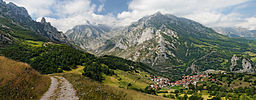- Cantabrian Mountains
-
Cantabrian Mountains Spanish: Cordillera Cantábrica Range The Picos de Europa overlooking the village of Sotres, in CabralesNamed for: Cantabria Country  Spain
SpainCommunities  Basque Country,
Basque Country,  Castile and León,
Castile and León,
 Cantabria,
Cantabria,  Asturias
AsturiasBorders on Pyrenees, Galicia Highest point Torre de Cerredo - elevation 2,648 m (8,688 ft) - coordinates 43°11′51″N 04°51′06″W / 43.1975°N 4.85167°W Length 300 km (186 mi), WE Width 50 km (31 mi), NS Geology limestone The Cantabrian Mountains or Cantabrian Range (Spanish: Cordillera Cantábrica) are one of the main systems of mountain ranges in Spain. They extend for more than approximately 180 miles (300 km) across northern Spain, from the western limit of the Pyrenees to the edges of the Galician Massif close to Galicia, along the coast of the Cantabrian Sea. The Cantabrian Mountains offer a wide range of trails for hiking, as well as many challenging climbing routes. Skiing is possible in the ski resorts of Alto Campoo, Valgrande-Pajares and Manzaneda.
These mountains are a distinct physiographic province of the larger Alpine System physiographic division. Their easternmost end meets the Sistema Ibérico.
Contents
Geography
 Torre de Cerredo, 2,650 m. The highest summit of the Cantabrian Mountains
Torre de Cerredo, 2,650 m. The highest summit of the Cantabrian Mountains
The Cantabrian Mountains stretch east-west, nearly parallel to the sea, as far as the pass of Leitariegos, also extending south between León and Galicia. The range's western boundary is marked by the valley of the river Miño (Portuguese: Minho), by the lower Sil, which flows into the Miño, and by the Cabrera River, a small tributary of the Sil.
As a whole, the Cantabrian Mountains are remarkable for their intricate ramifications, but almost everywhere, and especially in the east, it is possible to distinguish two principal ranges, from which the lesser ridges and mountain masses radiate. One range, or series of ranges, closely follows the outline of the coast; the other, which is loftier, forms the northern limit of the great tableland of Castile and León, and is sometimes regarded as a continuation of the Pyrenees. The coastal range rises in, some parts sheer above the sea, and everywhere has so abrupt a declivity that the streams which flow seaward are all short and swift.
The descent from the southern range to the high plateaux of Castile is more gradual, and several large rivers, notably the Ebro, rise here and flow to the south or west. The breadth of the Cantabrian chain, with all its ramifications, increases from about 60 m; in the east to about 115 m in the west. Many peaks are over 6000 ft high, but the greatest altitudes are attained in the central ridges on the borders of León, Asturias, Palencia and Cantabria. Here are the highest peak Torre de Cerredo (8,688 ft), Peña Vieja (8,579 ft), Peña Prieta (8,304 ft) and Espigüete (7,898 ft); an unnamed summit in the Picos de Europa, to which range the Peña Vieja also belongs, rises on the right bank of the Sella to a height of 8,045 ft; further west the peaks of Manpodres, Peña Ubiña, Peña Rubia and Cuiña all exceed 7,000 ft. A conspicuous feature of the chain, as of the adjacent tableland, is the number of its parameras, isolated plateaus shut in by lofty mountains or even by precipitous walls of rock.
The Cantabrian Mountains make a sharp divide between "Green Spain" to the north, and the dry central plateau. The north facing slopes receive heavy cyclonic rainfall from the Bay of Biscay, whereas the southern slopes are in rain shadow.
Main ranges
The Cantabrian Range has three very distinct sections:
- Western: The Asturian Massif in Asturias, León Province and Cantabria with paleozoic folds and east-west oriented rift valleys. The Sierra de Ancares is an extension, to the south-west, of the Cantabrian Mountains, forming the boundary between Galicia and Léon Province.
- Central: The Cantabrian Massif, in Cantabria. Mesozoic limestone and marl, with the Paramo de Masa and La Lora grasslands in the south crossed by the Rudrón Valley.[1]
- Eastern: Basque Mountains in The Basque Country and Navarre, with very eroded Mesozoic folds.
Flora and fauna
The Cantabrian Mountains are home to an important variety of plant life, as well as the Cantabrian brown bear (Ursus arctos pyrenaicus), catalogued as being in danger of extinction, which travels from Léon to areas in Palencia and Cantabria, and the Capercaillie (T. urogallus cantabricus).
Other animals associated with the range include the Iberian Wolf (Canis lupus signatus), Pyrenean chamois (Rupicapra pyrenaica) and the rebeco, or Cantabrian chamois (Rupicapra pyrenaica parva).
Ecology
The Cantabrian mountain range includes such important protected areas as the Picos de Europa National Park, which is one of several Cantabrian parks included in UNESCO's World Network of Biosphere Reserves. Some sites are included in the European Union's Natura 2000 network and Special Protection Areas for the Conservation of Wild Birds.
References
- ^ J. Muñoz Jiménez, Geografía de Asturias. 1 . Geografía física. El relieve, el clima y las aguas. 1982
Notes
 This article incorporates text from a publication now in the public domain: Chisholm, Hugh, ed (1911). Encyclopædia Britannica (11th ed.). Cambridge University Press.
This article incorporates text from a publication now in the public domain: Chisholm, Hugh, ed (1911). Encyclopædia Britannica (11th ed.). Cambridge University Press.
External links
- iberianature.com - English-language web site on nature in Spain and Portugal
- - The Cantabrian Institute of Biodiversity, devoted to the study of biodiversity in the Cantabrian Mountains
Coordinates: 43°00′N 5°00′W / 43°N 5°W
Subfields of physical geography  Categories:
Categories:- Mountain ranges of Spain
- Green Spain
- Physiographic provinces
Wikimedia Foundation. 2010.




